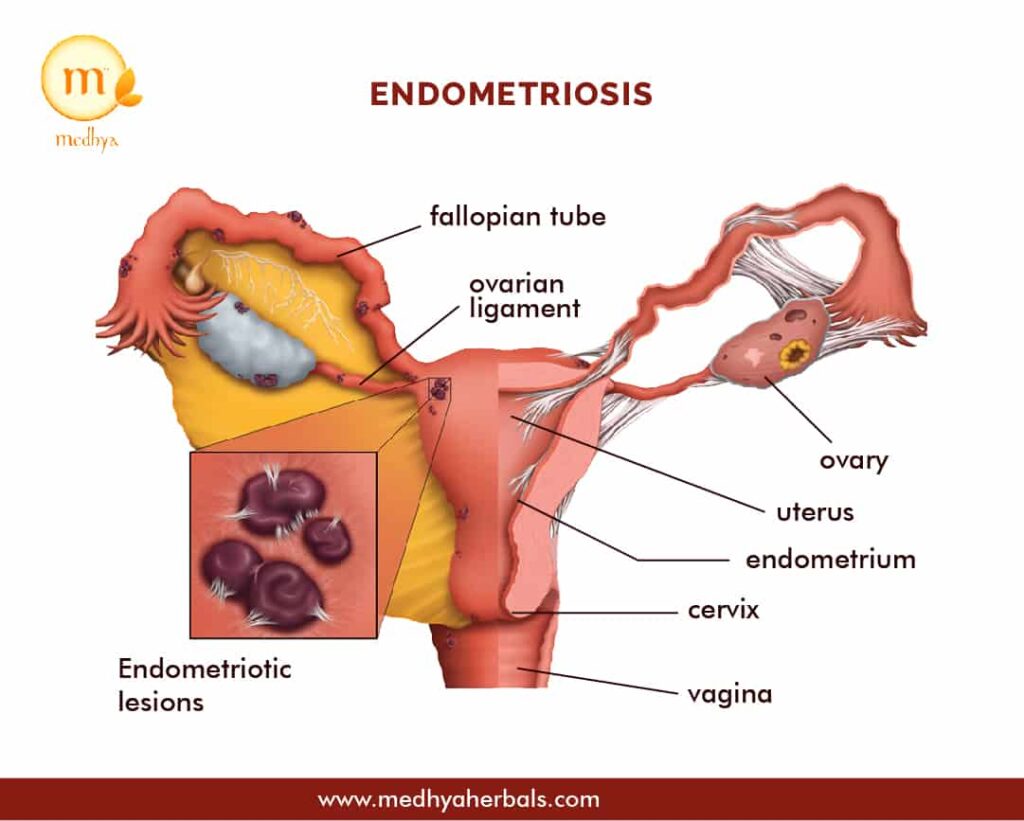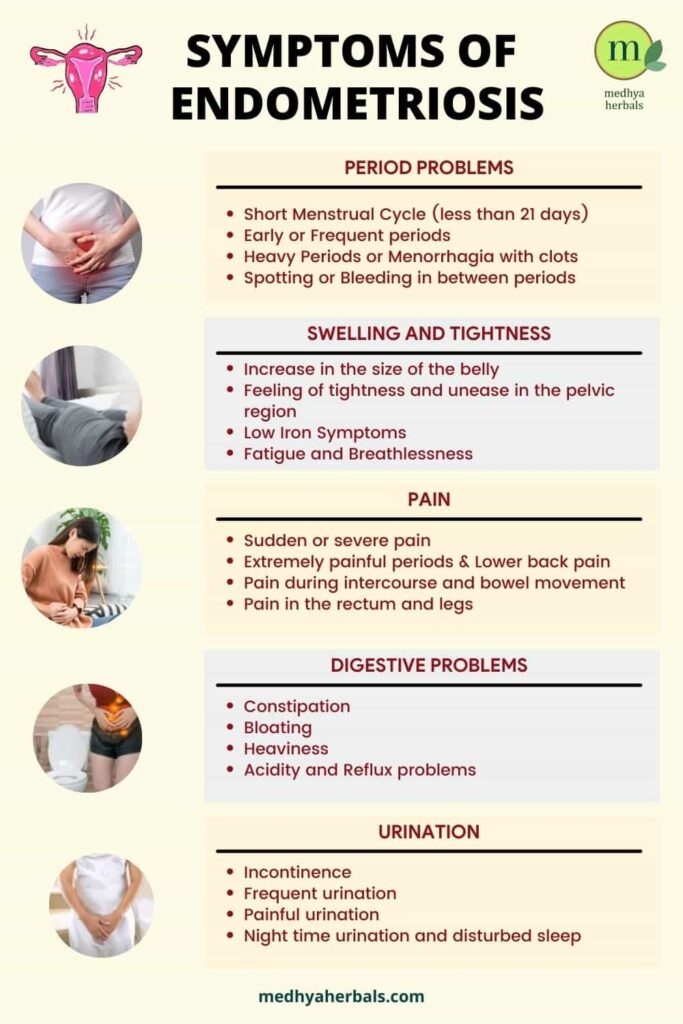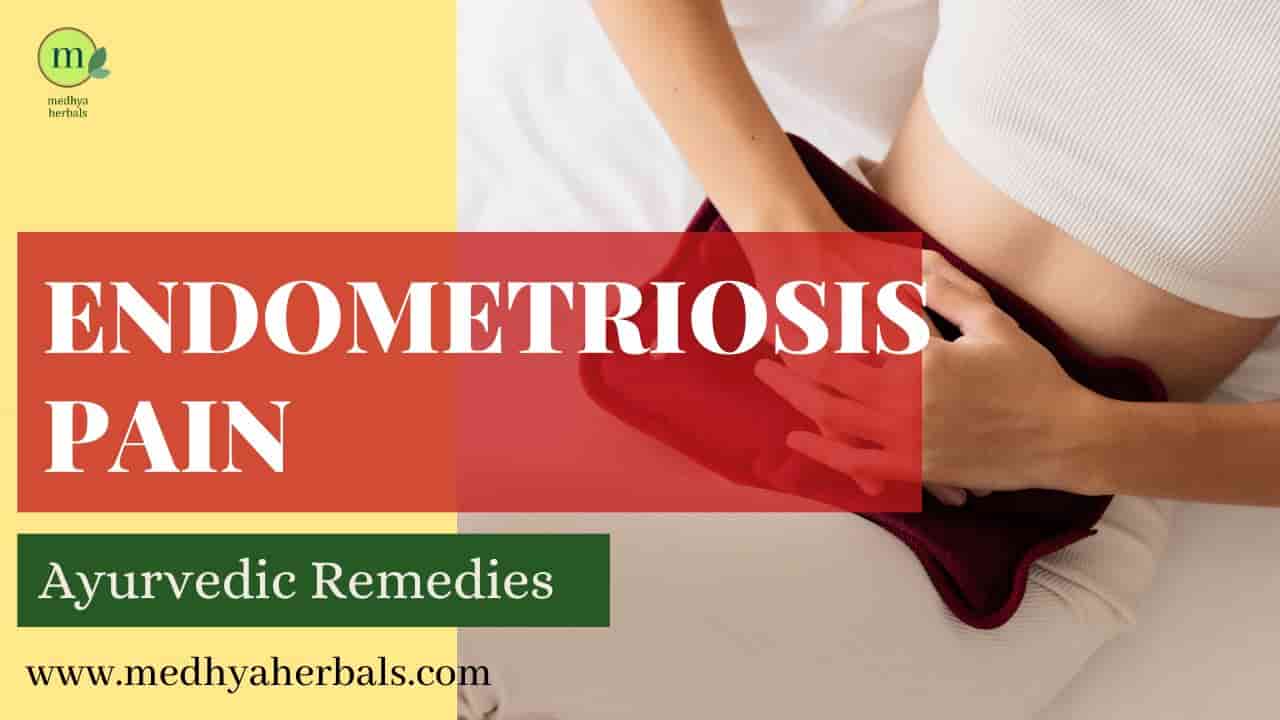Endometriosis pain can be incredibly debilitating, affecting your quality of life, relationships, and career. It can can manifest in various ways, from excruciating pain during sex and periods to pain in the back, legs, and even the ovaries.
If you’re reading this, you’ve probably experienced some of these symptoms yourself. You may feel like you’re constantly battling pain, and you may have tried countless treatments with little to no relief. I want you to know that you’re not alone. Endometriosis affects approximately 1 in 10 women of reproductive age, and the pain can be debilitating.
As an Ayurvedic doctor, I’ve seen the power of herbal remedies and natural treatments in managing and alleviating endometriosis pain. In this article, I will share with you five amazing ways to manage endometriosis pain, including personal stories, tips, and resources. Remember, you don’t have to suffer in silence. You deserve to live your life to the fullest, free from the burden of endometriosis pain.
Understanding Endometriosis
Endometriosis is a condition in which the tissue that normally lines the inside of your uterus grows outside of it such as on the ovaries, on the uterus or anywhere inside the pelvic cavity.

Endometriosis pain can vary in intensity and location depending on the stage of the condition. There are 5 stages of endometriosis, with stage 1 being the mildest and stage 5 being the most severe. The higher the stage, the more extensive the endometriosis tissue has spread throughout the body.
In stage 1 and 2, women may experience mild to moderate pain that is usually limited to the lower abdomen and pelvic area. However, as the disease progresses to stages 3 and 4, pain can become more severe and widespread.
Symptoms of Endometriosis
Endometriosis symptoms can vary from woman to woman, and some women may not experience any symptoms at all. However, there are four common symptoms that are associated with endometriosis:
- Painful periods: This is the most common symptom of endometriosis. Women with endometriosis often experience intense menstrual cramps that can last for several days. The pain can be so severe that it affects your daily activities.
- Pain during intercourse: Women with endometriosis may experience pain during or after sexual intercourse. The pain may be deep or sharp, and it can last for several hours after intercourse.
- Chronic pelvic pain: Some women with endometriosis may experience chronic pelvic pain that lasts for several months. The pain may be dull or sharp and can occur at any time during the menstrual cycle.
- Infertility: Endometriosis can cause infertility in some women. The condition can affect the ovaries and fallopian tubes, making it difficult for the egg and sperm to meet.

How Does Endometriosis Pain Feel Like?
Endometriosis pain can also occur in several locations in the body. The most common locations include the lower back, legs, and pelvis. Women may experience pain during sex, bowel movements, or urination. Some women may also have pain in their shoulders or chest due to the irritation of the diaphragm, which is the muscle that separates the chest and abdominal cavities.
Endometriosis pain can occur at any time during the menstrual cycle, but it is most likely to occur during menstruation. Women may also experience pain during ovulation, which can be felt on either side of the abdomen depending on which ovary is releasing an egg.
It’s important to note that endometriosis pain differs from regular menstrual pain. Menstrual pain is caused by contractions of the uterus, whereas endometriosis pain is caused by the growth and inflammation of endometrial tissue outside of the uterus. If you experience pain that is not relieved by over-the-counter pain medication or interferes with your daily activities, you should speak with your doctor to determine if endometriosis is the cause.
What Causes Endometriosis Pain?
Endometriosis pain can be triggered by a variety of factors. Some common triggers include:
- Hormonal fluctuations: Endometriosis pain is often associated with hormonal fluctuations during the menstrual cycle. The pain may be more intense during ovulation or right before menstruation.
- Inflammation: Endometriosis can cause inflammation in the pelvic region, which can lead to pain.
- Physical activity: Activities that put pressure on the pelvis, such as running or jumping, can trigger endometriosis pain.
- Stress: Stress can exacerbate endometriosis pain by causing tension in the pelvic region.
Natural Ways to Manage Endometriosis Pain
Dealing with the pain of endometriosis can be frustrating and overwhelming. It’s a condition that can have a major impact on your daily life, making it difficult to perform everyday tasks or enjoy your favorite activities.
While there are several medical treatments available such as birth control, IUD devices and even surgery; they only provide symptomatic relief. In most of the cases, endo pain and symptoms of endometriosis come back as soon as you stop the treatment.
This is where Ayurveda has an edge. By working on the root cause level, Ayurvedic treatment for Endometriosis gives you lasting relief from pain and other trouble symptoms of Endometriosis.
Personal Story of Overcoming Endometriosis Pain Naturally
As an Ayurvedic doctor, I have witnessed several women suffering from endometriosis pain. My patient ‘Tara’ had a similar experience. She suffered from severe pain every month, to the point that she could barely get out of bed. She felt trapped in a vicious cycle of pain and discomfort. Tara tried several medical treatments but they only provided temporary relief. This is when she decided to explore natural remedies.
After studying her case, I recommended Ayurvedic herbal medicines to support her body’s natural healing process. In addition, I guided her to follow helpful Ayurvedic practices, including yoga, meditation, and dietary changes.
Some of such changes for Endometriosis diet include taking anti-inflammatory foods like turmeric, ginger, and omega-3-rich foods. Within a few weeks, Tara started experiencing a significant reduction in pelvic pain and discomfort. Over time, she felt more in control of her endometriosis and was able to manage it better.
Now, let’s look into some highly effective Ayurvedic natural ways that will help you to find relief from Endo Pain.
1. Dietary Changes for Endometriosis Pain Relief
Diet plays a crucial role in managing endometriosis pain. Making the right dietary changes can help to reduce inflammation and regulate hormones, which are key factors in the development and progression of endometriosis.
Here are some dietary changes that can be a natural and effective way to manage endometriosis pain and improve overall health:
- Increase fiber intake: Eating fiber-rich foods like fruits, vegetables, whole grains, and legumes can help to reduce inflammation and promote regular bowel movements, which can alleviate pain and discomfort associated with endometriosis.
- Avoid trigger foods: Certain foods can trigger inflammation and exacerbate endometriosis pain. These include processed foods, fried foods, caffeine, alcohol, and sugar. Eliminating or reducing these foods from your diet can help to alleviate symptoms.
- Include healthy fats: Incorporating healthy fats like omega-3 fatty acids found in fish, flaxseeds, and walnuts can help to reduce inflammation and alleviate pain.
- Eat anti-inflammatory foods: Foods with anti-inflammatory properties like turmeric, ginger, and green leafy vegetables can help to reduce inflammation and alleviate pain associated with endometriosis.
- Consider a plant-based diet: Some studies suggest that a plant-based diet can help to reduce inflammation and improve symptoms of endometriosis. Plant-based diets focus on whole, nutrient-dense foods like fruits, vegetables, whole grains, and legumes.
2. Ayurvedic Herbal Supplements
Ayurveda is a holistic system of medicine that has been used for thousands of years to promote holistic healing of the body and mind. In my practice, I find these Ayurvedic herbal supplements and Ayurvedic medicines to be highly effective in alleviating endo pain, reducing inflammation, and to balance hormones:
- Ashwagandha: This herb has been used in Ayurveda for centuries for its anti-inflammatory properties. Ashwagandha helps in reducing stress and regulating hormones, which can help alleviate endometriosis pain.
- Turmeric: Turmeric is another potent anti-inflammatory herb that has been used in Ayurvedic medicine for centuries. Curcumin, the active compound in turmeric, helps in reducing inflammation and managing endometriosis pain.
- Shatavari: Shatavari is a herb that has been used in Ayurvedic medicine for its hormonal balancing properties. It can help reduce menstrual cramps and alleviate endometriosis pain.
- Triphala: Triphala is a combination of three herbs – amla, haritaki, and bibhitaki – that are used in Ayurvedic medicine for their anti-inflammatory and digestive properties. Triphala can help in reducing inflammation and pain associated with endometriosis.
- Guggulu: Guggulu is a resin extracted from the Commiphora mukul tree that has been used in Ayurvedic medicine for centuries for its anti-inflammatory and analgesic properties. Guggulu can help in reducing inflammation and alleviating endometriosis pain.
- Chaste Tree: Chaste Tree, also known as Vitex, is a herb that has been used in Ayurvedic medicine for its hormonal balancing properties. It can help regulate the menstrual cycle and reduce menstrual cramps and pain associated with endometriosis.
It is important to note that herbal supplements should be used under the guidance of a qualified Ayurvedic practitioner to ensure safety and effectiveness. Natural remedies should also not be used as a substitute for Endometriosis treatment, but rather as a complementary therapy to help manage endometriosis pain.
3. Heat Therapy
Heat therapy is a safe and effective way to manage endometriosis pain without relying on medication. Incorporating heat therapy into your self-care routine can help to reduce inflammation and alleviate discomfort in endometriosis.
There are several ways to use heat therapy for endometriosis pain relief:
- Heating pads: These can be purchased at most drugstores and are an easy way to apply heat directly to the lower abdomen or other areas of the body experiencing pain. Simply plug in the pad and adjust the temperature to your desired level.
- Hot water bottles: These are a traditional and affordable option for applying heat therapy. Fill the bottle with hot water and place it on the affected area for 15-20 minutes.
- Warm baths: A warm bath can be relaxing and soothing for endometriosis pain. Add some Epsom salts or essential oils for added benefits.
- Warm compresses: You can make your own warm compress by soaking a cloth in hot water and placing it on the affected area.
When using heat therapy, it’s important to not overheat the body, which can cause burns or further irritation. Stick to a moderate heat level and never fall asleep with a heating pad or hot water bottle on.
4. Yoga to Manage Endo Pain
Yoga is a gentle and effective way to manage endometriosis pain. Practicing yoga regularly can help improve blood circulation, reduce stress and inflammation, and alleviate pain. Additionally, specific yoga poses can help target the muscles and organs affected by endometriosis, providing relief and reducing discomfort.
Some helpful yoga poses for endometriosis include Child’s Pose, Cat-Cow Pose, Downward Facing Dog, Cobra Pose, and Butterfly Pose. These poses help to stretch and strengthen the pelvic region, improve flexibility, and ease menstrual cramps.
Yoga Sequence for Endo Pain Relief
Here is an easy yoga sequence with 6 steps for endometriosis pain relief:
- Begin in Child’s Pose to help stretch and open the hips and lower back. Take a few deep breaths in this pose.
- Move into Cat-Cow Pose, which helps to stretch the spine and ease tension in the lower back.
- From Cat-Cow, move into Downward Facing Dog to stretch the entire body and improve blood flow.
- Lower down into Cobra Pose to gently stretch the abdominal muscles and relieve menstrual cramps.
- Come into Butterfly Pose to stretch the inner thighs and groin area, which can become tight and painful during endometriosis flare-ups.
- End the sequence with Corpse Pose, allowing yourself to rest and fully relax the body and mind.
Remember to listen to your body and only do what feels comfortable for you. Consistent practice of this sequence can help to alleviate endometriosis pain and help you to heal your body naturally.
5. Acupuncture
Acupuncture is a traditional Chinese medicine technique that involves the insertion of thin needles into specific points on the body to stimulate the flow of energy and promote healing. Many women with endometriosis pain have found relief through acupuncture, as it helps to reduce inflammation, increase blood flow, and relieve muscle tension.
During an acupuncture session, the acupuncturist will first assess the individual’s overall health and the specific areas where they are experiencing pain. They will then insert the needles into specific points on the body, which are thought to correspond with different organs and energy meridians in the body. The needles are typically left in place for 20-40 minutes, during which time the individual may feel a mild tingling or sensation of warmth in the area.
Acupuncture is generally considered safe when performed by a trained and licensed practitioner. However, as with any medical treatment, there are some risks, including infection, bleeding, and nerve damage.
It is important to discuss the potential risks and benefits of acupuncture with your doctor before undergoing treatment. For those with endometriosis pain, regular acupuncture sessions may provide significant pain relief and improve overall well-being.
6. Lifestyle Changes to Prevent Endo Pain
A healthy stress free lifestyle lies at the crux of balanced hormones and excellent reproductive health in women. Here are certain healthy lifestyle changes that you should incorporate to prevent endometriosis pain and reduce endometriosis symptoms:
- Regular Exercise: Exercise helps in reducing stress, which is a major trigger for endometriosis pain. Regular physical activity also improves blood flow and helps in keeping the body in shape. It is important to choose low-impact exercises such as yoga, swimming, and walking to avoid any strain on the body.
- Balanced Diet: Eating a healthy, balanced diet is important for overall health and can also help manage endometriosis symptoms. Include more fruits, vegetables, whole grains, lean proteins, and healthy fats in your diet. Avoid processed foods, refined sugars, and excess caffeine and alcohol.
- Stress Reduction: High stress levels can trigger endometriosis pain. Finding ways to reduce stress such as meditation, deep breathing exercises, or taking regular breaks to relax can help reduce symptoms.
- Adequate Sleep: Getting enough sleep is essential for maintaining overall health and reducing endometriosis symptoms. Aim for at least 7-8 hours of sleep each night and maintain a consistent sleep schedule.
- Avoiding Toxins: Exposure to toxins can worsen endometriosis symptoms. Avoid smoking, alcohol, and environmental toxins such as pesticides, plastics, and chemicals.
Coping mechanisms to Manage Pain during Periods and Sex
Sex and periods can significantly increase the intensity of endo pain and make it uncomfortable or even unbearable at times. At these times, you may feel like popping in painkillers, however they are really damaging to your liver and kidneys in the long term.
Apart from the Ayurvedic natural ways that I have shared above, here are some natural mechanisms that can help you to cope up and manage endo pain:
- Heating pad or hot water bottle: Applying heat to the lower abdomen or lower back can help to ease menstrual cramps and endometriosis pain. Use a heating pad or hot water bottle for 15-20 minutes at a time.
- Relaxation techniques: Stress and anxiety can make endometriosis pain worse. Practicing relaxation techniques like deep breathing, meditation, or yoga can help to manage stress and improve pain levels.
- Communication with partner: It can be difficult to discuss endometriosis pain with a partner, but open communication is important. This can help to come up with ways to make sexual activity more comfortable, such as trying different positions or using lubrication.
- Pelvic floor physical therapy: A physical therapist can teach individuals exercises to strengthen and relax the muscles of the pelvic floor. This can help to alleviate pain during sex and improve overall pelvic health.
- Counseling: Living with chronic pain can be challenging, and it’s important to take care of one’s mental health as well. Counseling can help individuals cope with the emotional aspects of endometriosis pain and develop strategies to manage it more effectively.
Conclusion
If you’re struggling with endometriosis pain, know that you’re not alone. We understand how difficult it can be to find relief from this condition, but we want you to know that there is hope. Ayurvedic root cause treatment can provide a permanent solution to endometriosis pain, and our team at Medhya Herbals is here to help.
We specialize in creating personalized treatment plans for each of our patients, taking into account their unique symptoms, medical history, and lifestyle. Our Ayurvedic doctors will work with you to create a holistic approach that addresses the root cause of your pain, rather than simply managing the symptoms.
So, if you’re ready to take the first step towards a pain-free life, schedule a consultation with one of our Ayurvedic doctors today. Together, we can create a treatment plan that works for you and gives you the relief you deserve.
References
- “Complementary and Alternative Medicine (CAM) Therapies for Endometriosis”. (2017). Endometriosis Foundation of America. Retrieved from https://www.endofound.org/complementary-and-alternative-medicine-cam-therapies-for-endometriosis
- “Yoga for Women with Endometriosis: A Systematic Review”. (2020). Journal of Alternative and Complementary Medicine. Retrieved from https://www.liebertpub.com/doi/abs/10.1089/acm.2019.0136
- “The effect of acupuncture on pain and menstrual symptoms in patients with endometriosis: a clinical trial”. (2018). Gynecological Endocrinology. Retrieved from https://www.tandfonline.com/doi/abs/10.1080/09513590.2018.1528200
- “Diet and endometriosis: a focus on the evidence-based literature”. (2021). Current Opinion in Obstetrics & Gynecology. Retrieved from https://journals.lww.com/co-obgyn/Abstract/2021/08000/Diet_and_endometriosis___a_focus_on_the.11.aspx
- “Effectiveness of heat therapy in patients with dysmenorrhea: A systematic review and meta-analysis”. (2019). Evidence-Based Complementary and Alternative Medicine. Retrieved from https://www.ncbi.nlm.nih.gov/pmc/articles/PMC6403841/
- “Endometriosis: Pathogenesis and Treatment”. (2020). Annual Review of Medicine. Retrieved from https://www.annualreviews.org/doi/abs/10.1146/annurev-med-050715-104316
- “Endometriosis: A Comprehensive Update”. (2020). Journal of Obstetrics and Gynaecology Canada. Retrieved from https://www.jogc.com/article/S1701-2163(20)30498-7/fulltext

